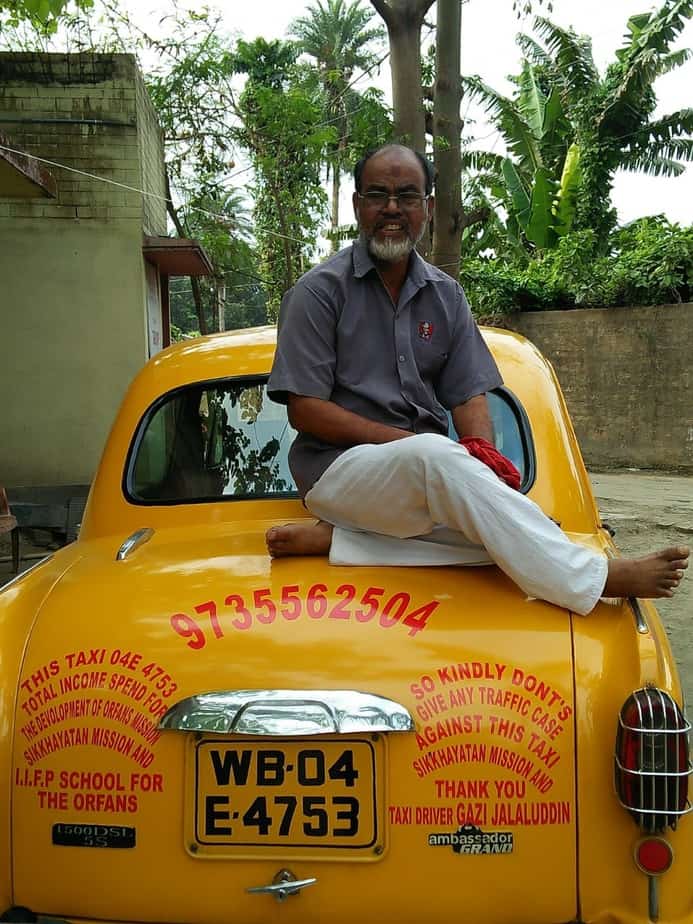
When Jalauddin Gazi first arrived in Kolkata from the Sunderbans, at age seven, nobody expected him to turn to social work as a hobby. Jalaluddin is now 70 and his fervour for helping those in need has not dimmed the slightest.
Jalaluddin himself was only able to study till class three, before he had to move to Kolkata with his father, only to beg on the sidewalks. At the age of 13, he began pulling a rickshaw in order to sustain his father and himself, and in another four years he was married and driving a taxi. This is where his tryst with battling illiteracy begins.
He started small, he admits. He looked around and realised that there were a number of young boys from poor homes, in his locality alone, who were illiterate, much like himself, and were not gainfully employed — so Jalaluddin decided to start a small driving school. The boys did not have to pay a single rupee for their training, instead, they had to make a promise. Jalaluddin made them commit that, once their training was over and they became employed, they would teach two other young boys, and contribute J5 every month, to a small fund that he was accumulating for the next part of his plan. This training programme started with 10 boys, and over the decades, has seen at least 400 students pass through, some that stayed on, and some didn’t.
After the success of his drivers’ training programme, Jalaluddin turned his attention to a project of slightly larger proportions. He wanted to build a primary school for underprivileged children and orphans in the Sunderbans. It was going to be called Sunderbans Shikshayatan. He made fliers and distributed them on the streets, started conversations with his passengers about his endeavours, gave speeches at any local event that would allow him stage time, and marketed and tirelessly publicised his project all by himself. Until finally, he was able to raise enough money to build a house with two rooms on a small patch of his father’s land. One room for him and his wife, and the other for the children who enrolled the school.
He started with 22 students and two teachers in the month of January in 1998. By the time 2006 rolled around, the school had 12 rooms, three washrooms, a room for serving midday meals, and a tubewell for good measure. The school now had 200 students, eight teachers, and two support staff members.
In a few years though, he realised that with no playground to speak of, and holding classes in the rooms next to the one in which he lives, was denying the students of a holistic schooling experience. Hence the marketing began again, so that he could raise enough funds to build a school in a more fitting location. Luckily, he came across two passengers, Saha and Ghosh, who took a keen interest in his project and helped him to identify and purchase the land. These two gentlemen guided him and were there with him every step of the way while the school was being built. By 2009 the second school was successfully inaugurated. This one too, grew to the proportions of the previous one, without taking as long. By 2011, the two establishments had 400 students, 16 teachers and four support staff members collectively.
Needless to say, Jalaluddin Gazi did not stop at that. He now wanted to build an orphanage in the Sunderbans. He remembers a particularly charitable customer, who played a huge role in contributing for the land for the orphanage. And in 2014, they were able to break ground on Sunderbans Orphanage and Social Welfare Trust. The orphanage had already enrolled 25 children when they came to the realisation that the building was surrounded by water bodies, and in the monsoons the water logging was extremely difficult to navigate. And unfortunately the establishment had to be closed down.
The small two-storey building stayed abandoned for years before it too became an itch in Jalaluddin’s side. In early 2017, he decided to turn it into a school for classes five through ten. He started out with 16 students and two teachers. These numbers did not remain for long, as the school now has 86 students and five teachers. The students are all enrolled into board exams through other schools with the necessary connections while they receive all their education close to home.
How does one begin to thank a man who has consistently dedicated his life to uplift the lives of the poverty-stricken youth?
This is a man who came from a family of negligible means and who spent his younger days begging on the sidewalk, unsure of his next meal. He somehow manages to keep selfishness and greed at bay, and raise money to try and make sure that the kids of this generation don’t have to give up on education after class three. These are the people we need to thank and these are the children we need to raise — this is how we make the world a better place.
He was accompanied by Uruguay great and close friend Luis Suarez and Argentina teammate Rodrigo…
A team of the Goa Police, along with the Luthra brothers, landed at the Manohar…
Johar celebrated the news by sharing the screenshot of Oscar's list that mentions "Homebound" in…
An AQI between 0 and 50 is considered 'good', 51 to 100 'satisfactory', 101 to…
UN Secretary General Antonio Guterres will attend the India–AI Impact Summit 2026 that will be…
From Connaught Place to Buddha Jayanti Park, Delhi’s quiet community of outdoor readers finds warmth,…